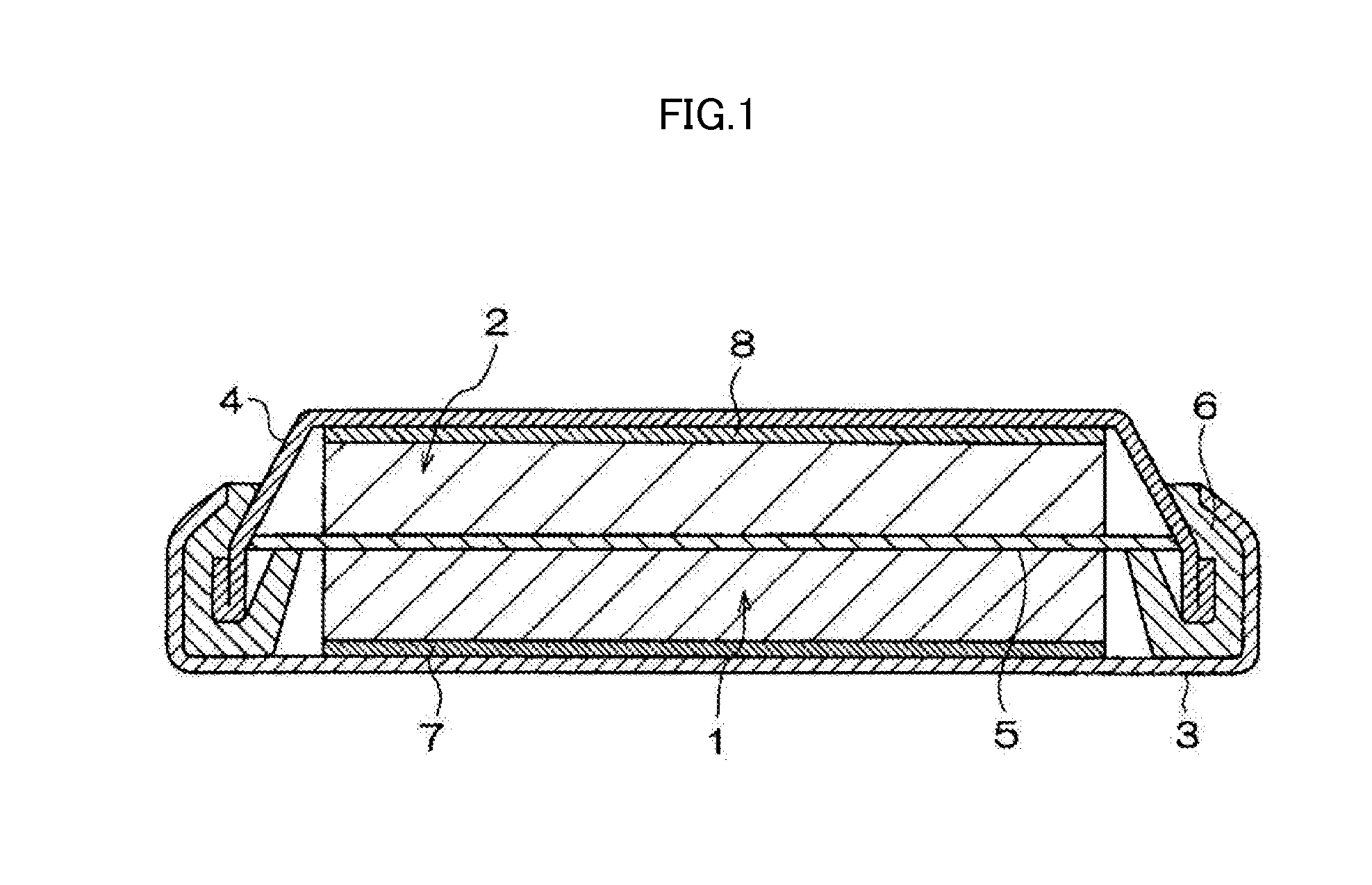Cyclic sulfate compound, non-aqueous electrolyte solution containing same, and lithium secondary battery
a technology of cyclic sulfate and non-aqueous electrolyte solution, which is applied in the direction of electrochemical generators, sustainable manufacturing/processing, final product manufacturing, etc., can solve the problems of constant increase in resistance and decrease in battery performance, and achieve the effect of improving the capacity retention performance of the battery and suppressing the decrease in open circuit voltag
- Summary
- Abstract
- Description
- Claims
- Application Information
AI Technical Summary
Benefits of technology
Problems solved by technology
Method used
Image
Examples
synthesis example 1
Synthesis of 4-methylsulfonyloxymethyl-2,2-dioxo-1,3,2-dioxathiolane (exemplary compound 1)
[0233](Step 1)
[0234]47.0 g (85% yield) of 4-hydroxymethyl-2-oxo-1,3,2-dioxathiolane was obtained from glycerol (36.8 g) and thionyl chloride (47.6 g) according to the method described in Tetrahedron: Asymmetry, 1999, vol. 10 (24), p. 4755-4762.
[0235](Step 2)
[0236]4-Hydroxymethyl-2-oxo-1,3,2-dioxathiolane (6.91 g, 50.0 mol) thus obtained was dissolved in tetrahydrofuran (140 ml), and under ice cooling, triethylamine (13.9 ml, 100 mmol) and methanesulfonyl chloride (4.3 ml, 55 mmol) were added thereto. The mixture was stirred for 3 hours. Water was poured into the reaction mixture, and the mixture was extracted with ethyl acetate. The extract was washed with a dilute aqueous hydrochloric acid solution and saturated brine, subsequently dried over anhydrous magnesium sulfate, and concentrated. The residue was purified by silica gel chromatography (elution solvent: hexane / ethyl acetate=2 / 3), and th...
synthesis example 2
Synthesis of 4-ethylsulfonyloxymethyl-2,2-dioxo-1,3,2-dioxathiolane (exemplary compound 2)
[0243]The same operation as that carried out for the synthesis of the exemplary compound 1 was carried out, except that in the Step 2 for the synthesis of the exemplary compound 1, methanesulfonyl chloride was changed to ethanesulfonyl chloride, and thus an exemplary compound 2 (3.37 g, 63% yield) was obtained.
[0244]The NMR analysis results for the exemplary compound 2 were as follows.
[0245]1H-NMR (270 MHz, CDCl3) δ(ppm): 5.23-5.16 (1H, m), 4.83 (1H, dd, J=9.2, 6.6), 4.65 (1H, J=9.2, 5.9), 4.52 (1H, dd, J=12.5, 4.0), 4.47 (1H, dd, J=12.5, 4.0), 3.26 (2H, q, J=7.6), 1.48 (3H, t, J=7.6)
synthesis example 3
Synthesis of bis((2,2-dioxo-1,3,2-dioxathiolane-4-yl)methyl) sulfate (exemplary compound 16)
[0246](Step 1)
[0247]The same operation as that carried out in Step 1 for the synthesis of the exemplary compound 1 was carried out, and thus 4-hydroxymethyl-2-oxo-1,3,2-dioxathiolane was obtained.
[0248](Step 2)
[0249]4-Hydroxymethyl-2-oxo-1,3,2-dioxathiolane (2.40 g, 17.4 mol) obtained in Step 1 was dissolved in methylene chloride (50 ml), and under ice cooling, triethylamine (3.6 ml, 26 mmol) and thionyl chloride (0.89 ml, 8.7 mmol) were added thereto. The mixture was stirred for 18 hours. Water was poured into the reaction mixture, and the mixture was extracted with methylene chloride. The extract was washed with a dilute aqueous hydrochloric acid solution and saturated brine, subsequently dried over anhydrous magnesium sulfate, and concentrated. The residue was purified by silica gel chromatography (elution solvent: hexane / ethyl acetate system), and thus bis((2-oxo-1,3,2-dioxathiolan-4-yl)m...
PUM
| Property | Measurement | Unit |
|---|---|---|
| temperature | aaaaa | aaaaa |
| temperature | aaaaa | aaaaa |
| temperature | aaaaa | aaaaa |
Abstract
Description
Claims
Application Information
 Login to View More
Login to View More - R&D
- Intellectual Property
- Life Sciences
- Materials
- Tech Scout
- Unparalleled Data Quality
- Higher Quality Content
- 60% Fewer Hallucinations
Browse by: Latest US Patents, China's latest patents, Technical Efficacy Thesaurus, Application Domain, Technology Topic, Popular Technical Reports.
© 2025 PatSnap. All rights reserved.Legal|Privacy policy|Modern Slavery Act Transparency Statement|Sitemap|About US| Contact US: help@patsnap.com



